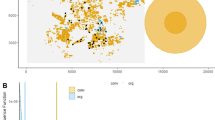Abstract
Land managers need better techniques to assess exoticplant invasions. We used the cross-correlationstatistic, I YZ, to test for the presence ofspatial cross-correlation between pair-wisecombinations of soil characteristics, topographicvariables, plant species richness, and cover ofvascular plants in a 754 ha study site in RockyMountain National Park, Colorado, U.S.A. Using 25 largeplots (1000 m2) in five vegetation types, 8 of 12variables showed significant spatial cross-correlationwith at least one other variable, while 6 of 12variables showed significant spatial auto-correlation. Elevation and slope showed significant spatialcross-correlation with all variables except percentcover of native and exotic species. Percent cover ofnative species had significant spatialcross-correlations with soil variables, but not withexotic species. This was probably because of thepatchy distributions of vegetation types in the studyarea. At a finer resolution, using data from ten1 m2 subplots within each of the 1000 m2 plots, allvariables showed significant spatial auto- andcross-correlation. Large-plot sampling was moreaffected by topographic factors than speciesdistribution patterns, while with finer resolutionsampling, the opposite was true. However, thestatistically and biologically significant spatialcorrelation of native and exotic species could only bedetected with finer resolution sampling. We foundexotic plant species invading areas with high nativeplant richness and cover, and in fertile soils high innitrogen, silt, and clay. Spatial auto- andcross-correlation statistics, along with theintegration of remotely sensed data and geographicinformation systems, are powerful new tools forevaluating the patterns and distribution of native andexotic plant species in relation to landscape structure.
Similar content being viewed by others
References
Bartell, S. M. and Brenkert, A. L.: 1991, ‘A Spatial-Temporal Model of Nitrogen Dynamics in a Deciduous Forest Watershed’, in Turner, M. G. and Gardner, R. H. (eds.), Quantitative Methods in Landscape Ecology, Ecological Studies Vol. 82, Springer-Verlag, New York, pp. 379–398.
Bonham, C. D., Reich, R.M. and Leader, K. K.: 1995, ‘Spatial cross-correlation of Boutelua gracilis with site factor’, Grassland Science 41, 196–201.
Cliff, A. D. and Ord, J. K.: 1981, Spatial Processes, Models and Applications, Pion Ltd., London, England, pp. 21–45.
Chong, G. W., Reich, R. M., Kalkhan, M. A. and Stohlgren, T. J.: 1999, ‘New approaches for sampling and modeling native and exotic species’, Contributed paper; in The EMAP Symposium on Western Ecological Systems: Status, Issues and New Approaches, San Francisco, California, U.S.A.
Czaplewski, R. L. and Reich, R. M.: 1993, ‘Expected value and variance of Moran's bivariate spatial autocorrelation statistic under permutation’, USDA For. Serv. Res. Paper RM-309. Fort Collins, Colorado, pp. 1–13.
ESRI: 1994, Environment Systems Research Institute, Inc, 380 New York Street, Redlands, CA 92373, U.S.A.
Fortin, M. J., Drapeau, P. and Legendre, P.: 1989, ‘Spatial auto-correlation and sampling design in plant ecology’, Vegetatio 83, 209–222.
Gee, G. T. and Bauder, J. W.: 1986, ‘Particle-Size Analysis’, in Klute, A. (ed.), Methods of Soil Analysis. Part 1. Physical and Mineralogical Methods, 2nd Ed., American Society of Agronomy, Madison, WI, pp. 383–411.
Kalkhan, M. A., Stohlgren, T. J. and Coughenour, M. B.: 1995, ‘An Investigation of Biodiversity and Landscape-Scale Gap Patterns using Double Sampling: A GIS Approach’, in Proceeding of the Ninth Conference on Geographic Information Systems, Vancouver, British Columbia, Canada, pp. 708–712.
Kalkhan, M. A., Reich, R. M. and Stohlgren, T. J.: 1998, ‘Assessing the accuracy of Landsat Thematic Mapper classification using double sampling’, Int. J. Remote Sensing 19, 2049–2060.
Klauber, M. R.: 1975, ‘Space-time clustering for more than two samples’, Biometrics 31, 719–726.
Mantel, N.: 1967, ‘The detection of disease clustering and a generalized regression approach’, Cancer Res. 27, 209–220.
Moran, P. A. P.: 1948, ‘The interpretation of statistical maps’, Roy. Stat. Soc., Ser. B 10, 243–351.
Olsen, A. R. and Schreuder, H. T.: 1997, ‘Perspectives on large-scale natural resource surveys when cause-effect is a potential issue’, Environ. and Ecol. Stat. 4, 167–180.
Peet, R. K.: 1988, ‘Forest of the Rocky Mountains’, in Barbour, M. G. and Billings, W. D. (eds.), North American Terrestrial Vegetation, Cambridge University Press, Cambridge, MA, pp. 64–103.
Reich, R. M., Czaplewski, R. L. and Bechtold, W. A.: 1995, ‘Spatial cross-correlation of undisturbed natural shortleaf pine stands in northern Georgia’, Environ. and Ecol. Stat. 1, 201–217.
Scheaffer, R. L., Mendenhall, W. and Ott, L.: 1990, Elementary Survey Sampling, 4th Ed., PWS-Kent Publishing Company, Boston, MA, 390 pp.
Stohlgren, T. J., Falkner, M. B. and Schell, L. D.: 1995, ‘A modified-Whittaker nested vegetation sampling method’, Vegetatio 117, 113–121.
Stohlgren, T. J., Chong, G. W., Kalkhan, M. A. and Schell, L. D.: 1997a, ‘Rapid assessment of plant diversity patterns: A methodology for landscapes’, Environ. Monitoring and Assess. 48, 25–43.
Stohlgren, T. J., Chong, G. W., Kalkhan, M. A. and Schell, L. D.: 1997b, ‘Multi-scale sampling of plant diversity: Effect of minimum mapping unit size’, Ecol. Appl. 7, 1064–1074.
Stohlgren, T. J., Bull, K. A. and Otsuki, Y.: 1998a, ‘Comparison of rangeland vegetation sampling techniques in the Central Grasslands’, J. Range Manage. 51, 164–172.
Stohlgren, T. J., Bull, K. A., Otuski, Y., Villa, C. A. and Lee, M.: 1998b, ‘Riparian zones as havens for exotic plant species in the central grasslands’, Plant Ecology 138, 113–125.
Stohlgren, T. J., Binkley, D., Chong, G. W., Kalkhan, M. A., Schell, L. D., Bull, K. L., Otsuki, Y., Newman, G., Bashkin, M. and Son, Y.: 1999, ‘Exotic plant species invade hot spots of native plant diversity’, Ecological Monographs 69, 25–46.
Wartenberg, D.: 1985, ‘Multivariate spatial correlation: A method for exploratory geographical analysis’, Geographical Anal. 17, 263–283.
Author information
Authors and Affiliations
Corresponding author
Rights and permissions
About this article
Cite this article
Kalkhan, M.A., Stohlgren, T.J. Using Multi-Scale Sampling and Spatial Cross-Correlation to Investigate Patterns of Plant Species Richness. Environ Monit Assess 64, 591–605 (2000). https://doi.org/10.1023/A:1006329707198
Issue Date:
DOI: https://doi.org/10.1023/A:1006329707198




